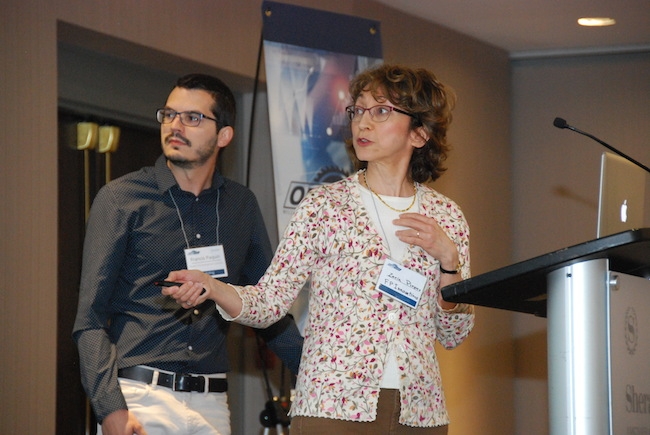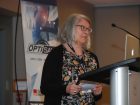
Features
Mills
Sawmilling
Sawmillers glimpse industry future at OptiSaw 2018
June 7, 2018 - From machine “deep learning” artificial intelligence for lumber grading to using near-infrared spectroscopy to sort species, speakers at OptiSaw mill automation and optimization forum gave their audience a rare glimpse into the future of sawmilling.
June 7, 2018 By Maria Church
 FPInnovation’s Zarin Pirouz
FPInnovation’s Zarin Pirouz More than 50 mill owners, managers, and optimization staff gathered at the Sheraton hotel in Richmond, B.C., on Tuesday for Canadian Forest Industries’ annual OptiSaw forum. The day’s agenda covered the newest innovations in sawmill technology, and gave attendees a chance to ask manufacturers what the future holds for the industry.
Joey Nelson, president of JoeScan, began the day with a presentation on the keys to successful scanning on the trimmer sorter line. He outlined the importance of data density, face coverage and accuracy of a scanning system, and suggested a regular testing intervals of the entire system with randomly selected boards to ensure the scanners are at peak performance.
Autolog’s Francis Paquin and FPInnovation’s Zarin Pirouz gave a joint presentation next on the use of near-infrared spectroscopy to automatically separate wood species. “Near infrared radiation (NIR) is invisible to the human eye and harmless, and absorption rate depends on the material,” Paquin told the crowd. When NIR is illuminated on boards each species will absorb and reflect it differently, which allows sensors to distinguish between them.
In various test cases, NIR spectroscopy was able to predict the species with around or greater than 95 per cent accuracy. This degree of accuracy would be best suited for sorting species for kiln drying, which is more forgiving if there are mistakes, Pirouz says. However, testing is underway to use the technology at the planer mill as well.
Cathy Johnston with Brunette Machinery spoke next on challenges and benefits of repairing or replacing equipment. She shared a case study of a recently installed retract to load (RTL) log singulator at Carrier Lumber in Prince George, B.C. The new installation was made to reduce conveyor maintenance and machine wear parts.
Springer-Microtec’s Norvin Laudon was up next to discuss how they are using X-ray technology to execute CT log scanning solutions at the sawline. Their CT log scanner and Logeye Fingerprint scanner used in combination connect the log yard merchandizer with the saw line to create a re-optimized scanning solution. The X-ray scanner is able to pick up internal splits, knots and rot, Laudon said. He shared a case study on the system installed at Idaho Forest Group.
Discussion then turned to artificial intelligence advancements at the sawmill with a presentation from Lucidyne’s Patrick Freeman.
“Haven’t we all been using AI for years? The answer is yes, but no one is scanning perfectly and where there are imperfections there are opportunities for improvement,” Freeman said.
Freeman gave a technical overview deep learning in the field of artificial intelligence and gave examples of advancements in other industries, such as autonomous driving. Lucidyne is using those same principles of machine learning for defect detection in wood. Called Perceptive Sight, Lucidyne is teaching its system to recognize more than 50 board defects using RGB colour, tracheid sensors, T3 sensors, throughboard sensors and geometric sensors. They are using a full-time crew of certified lumber graders to painstakingly teach the machine to recognize those defects in 14 lumber species. Both the species and defect types are growing, Freeman said. The first Perceptive Sight system was installed in March 2017 and interest is growing with about one installation or upgrade each month, he said.
Francis Petit with VETS Group was up next with a presentation on wood dust risks and air quality hazards. He shared solutions to reduce the dust exposure for the workforce and to prevent catastrophic wood dust explosions at sawmills. “The key is to recognize there is a risk and to deal with it,” Petit said. Minimize the fuel by reducing the dust in the mill, and you minimize the explosion, he said.
Ingo Wallocha with Valutec followed with a talk comparing unidirectional continuous dry kilns with counter-flow continuous dry kilns. His presentation included a discussion of drying demands for the cross laminated timber industry. “You have to have very tight standard deviation otherwise you will have problems with the end product,” he said.
FPInnovations’ Eric Dunn presented next on their SM2 initiative — a series of research projects on smart and flexible manufacturing that can improve operational performance at sawmills. Dunn gave an overview of the projects, which includes the NIR spectroscopy project detailed earlier, as well as ones on other methods of tree identification, automation in the saw filing room, real-time planer adaptive control, and optimizing kiln drying. One project is a commercial demo of a continuous precision radio frequency drying, which will take place this summer.
Cumul8’s Rory Armes’ followed with a presentation on his company’s data analytics and internet of things platform, and how it is applied to the forest industry for predictive maintenance. “There’s a lot of data out there but it’s not being analyzed,” Armes said. It’s not hard to do, he said, but it requires storage on a cloud network and the production of a dashboard that reports on machine heath and alerts operators to potential problems before they happen.
John Wilby with ScanMeg wrapped up the day with a presentation on a series of photocells and scanning devices and their applications at sawmills that can immediately increase productivity and reduce downtime. He covered several small case studies of mills using the devices in unique ways improve machine performance.
Find archives of the presentations on www.optisaw.com soon, and watch for news of our OptiSaw event coming to Montreal in late fall.
Print this page















